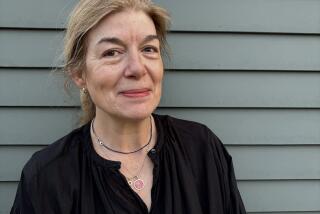Skeletons in the closet
POOR, poor books. They have to be about me to keep my interest. My brain can’t help it; it shuffles through whatever I’m reading like a flip book, until I see myself a little more clearly than I did before.
I know how sad this is. It means that most of the books on my shelf were abandoned the minute I got to a stretch without feminists, Jews or teenage girls having identity crises.
Alison Bechdel, author of the graphic novel “Fun Home,” is a lesbian, which -- to me, at least -- is sort of like being a feminist. She’s also dealing with the question of identity, although for her it’s not just personal, but a family issue as well. The Fun Home was the Bechdels’ inside name for their family funeral home, which was run by the author’s father, Bruce. But it wasn’t really fun.
Bruce Bechdel was in the closet, albeit a somewhat transparent one. He lorded over both his family and the funeral business from his extravagantly decorated study. He also held court there with handsome boys from the local high school, where, when he wasn’t embalming, he taught English.
The study. Oooh, that study, which Bechdel’s father called the “library,” is one of the many great fictions of his life. Here’s where the graphic part of the graphic novel concept really pays off. It’s all there in exquisite rendering. The picture Bechdel draws is better than the one I would have sketched in my brain had I been only reading. It’s even modified with little labeled arrows pointing to the way the wallpaper is FLOCKED, the curtains are VELVET, the statue is of MEPHISTOPHELES and the man on the lampshade base is DON QUIXOTE.
In the 1970s, while my parents were doing musical theater in Chicago, Bechdel’s parents were doing “The Importance of Being Earnest” at the local theater in a town called Beech Creek, near the Allegheny forest. Bechdel uses the geography of this area -- in particular, the ridge that cuts it off from the rest of rural Pennsylvania -- as a metaphor for her father’s closetedness. She often imagines that this man who created such detailed artifice -- making dead people look lovely, calling a room in his house the library and teaching high school because he liked “teaching” as opposed to “high school boys” -- might have had a life that turned out differently had he been able to escape the gravitational tug of Beech Creek.
Bechdel’s exquisite re-creation of her childhood suggests that the worst thing about being a kid is that you simply can’t leave like you can when you’re an adult. Here we all are, she seems to be saying -- sometimes women more than men, but frankly, all of us -- trying to create lives that are authentic while reeling from the fact that we were, in a way, held hostage in homes that may or may not have reflected our realities. That for the most part, to be honest, did not. Reading “Fun Home” made me wish I had films of my childhood, not of the birthday parties or the family trips, but of the Saturday afternoons from 2 to 3, when nothing was happening and my sister and I were accused of being too loud or too silly or too much like children.
Luckily, Bechdel was a compulsive journal keeper, one who wrote and drew all along. Everything is there in vivid detail. A chapter called “The Canary-Colored Caravan of Death” is breathtaking in its portrayal of a dream she had a couple of nights before her father’s death. In a part of the woods called the Bullpen, she begs her dad to hurry up, but when he gets to her, the sunset is gone. Turn the page and Bechdel scolds both herself and us for getting so drawn in. “If this was a premonitory dream,” she writes, “I can only say that its condolence-card association of death with a setting sun is maudlin in the extreme.”
Bechdel’s dad killed himself a few days after she came out to him. Maybe. Or maybe he died in an accident that looked a lot like a suicide a few days after she told him something he’d known for a long time -- that, as in Oscar Wilde’s world of social hypocrisies, he wasn’t the only person in his home living under false pretenses.
Bechdel fought madly against her surroundings and compulsions to find a way out by using her pen, creating both pictures and words to make sense of her place in this erudite, academic and ultimately very lonely family. One poignant panel shows all four Bechdels (she has a younger brother as well) sitting in their own rooms, alone, doing solitary things -- reading, drawing, practicing lines for a play.
Sometimes, words and pictures aren’t enough. And yet, this is where the graphic novel format truly pays off. At one point, Bechdel shows us how she wrote the words “I THINK” in tiny letters between every sentence in her journal, not sure that even something she saw happen actually had. A few pages later, she adopts a copyreader’s insert symbol ({circ}) as a private stand-in for the words I THINK. Soon afterward, all her journal pages have that same giant symbol written across them, to nullify.
As much as she isn’t sure of what she’s seeing, Bechdel’s great care in documenting the female coming-of-age experience is radical, even groundbreaking. In one sequence, she visits a construction site. On the way, she happens upon a girlie calendar -- the first moment she “gets” the idea of the male gaze. Her reaction is persuasive, accessible: “I felt as if I’d been stripped naked myself, inexplicably ashamed, like Adam and Eve.”
A few panels later, Bechdel and her brother get in the cab of a tractor, where the driver has yet another nudie poster. Out of nowhere, she tells her brother to call her Albert instead of Alison. The complex issues of revolving identities and gender switches -- also borrowed, in some sense, from Wilde -- come into play yet again.
At times, Bechdel’s prose gets a little opaque -- not because she’s a bad writer, but because I didn’t pay attention in high school. Here is how she describes the moment in the tractor, in words, as opposed to art: “My stratagem strikes me as a precocious feat of Proustian transposition -- not to mention a tidy melding of Proust’s real Alfred and his fictional Albertine.”
Proust? Proust didn’t even make it into this review until now, even though he was all over the book.
None of that means I didn’t appreciate Bechdel’s complicated mind and multiplicity of talent -- what with the gorgeous writing and stunning drawings in tandem. “Fun Home” is an intricate document of a childhood that, ultimately, was enough like mine -- only with a few more literary references -- that for me, it worked.
More to Read
Sign up for our Book Club newsletter
Get the latest news, events and more from the Los Angeles Times Book Club, and help us get L.A. reading and talking.
You may occasionally receive promotional content from the Los Angeles Times.







